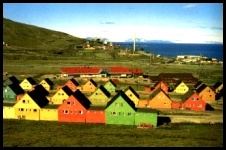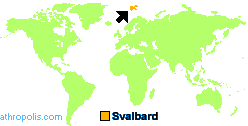
 Svalbard - Last Rest Stop Before the Pole Svalbard lies about 400 miles / 645 km north of Norway and is composed of five major islands (including the Spitsbergen group of islands) and many small ones. Although its capital city is Longyearbyen, it is only home to about 3,000 people - a population that is almost entirely seasonal. The name "Svalbard" means "the cold coast". The area was well known to the Vikings, but it wasn't rediscovered until 1596. It then became a centre for whaling, hunting and trapping. In 1920 the League of Nations awarded the islands to Norway, but the rights to mineral deposits were shared with Denmark, Italy, Japan, the Netherlands, Sweden, the United Kingdom, the United States, and Russia.
Byrd and Bennett were the first to fly over the Pole from Svalbard in 1926. The same year Nobile, Amundsen and Ellsworth left there to cross the Pole in a dirigible, and the submarine USS Nautilus stopped there after travelling under the ice cap in 1958.
Click pictures for more information and credits. Library: Arctic, Exploration Explorers, Whales/Fish Links: Arctic Arctic Maps & Weather Reports |

|
DICTIONARY: Just "double-click" any unlinked word on this page for the definition from Merriam-Webster's Student Electronic Dictionary at Word Central. |

|
ARCTIC LIBRARY & GLOSSARY: Check this section for an index of the rest of the things you really need to know about the Arctic. |

|
ARCTIC MAPS & WEATHER REPORTS: Maps of the Northwest Passage, explorers' routes, iceberg sources, Nunavut, the Arctic by treeline, temperature... |

|
ARCTIC LINKS: Even more information! Links to sites related to the Arctic and "Iceberg: the Story of the Throps and the Squallhoots". |

|
GUIDE TO ARCTIC SUNRISE & SUNSET: How much sunlight or darkness is there in the Arctic on each day of the year? |
to is the property of their respective owners, and Athropolis is not responsible for their content.
